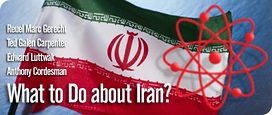Like Ed Luttwak, I see a great many grays and uncertainties, not blacks and whites. I’ve never been much for blogging, and this exercise has simply persuaded that it leads to forms of “soapboxing” that fail to add much insight.
There are, however, a few additional points that I feel need to be considered if anyone ever tries to go from all this rhetoric to practice.
1. Military options are fine to talk about in theory, but no one involved in this exchange knows the U.S. estimate of how well it can actually target Iranian activity, and exactly what would survive. Given its recent history, U.S. intelligence is likely to be more willing than usual to admit uncertainty. We need to remember, however, that we are the country that failed to assess Iraq’s efforts before 1990, gross overestimated wartime damage in 1991, continued to underestimate capabilities up to 1995, over estimated them after 1998, and got it horribly wrong in 202-2003. Not a confidence builder in targeting and damage assessment terms, particularly after our earlier fiasco in Desert Fox, and our inability to characterize the contents and damage done to many fixed facilities in Kosovo and then in Iraq in 2003.
It seems likely to me that we could do some damage now, but would leave most of the Iranian technology base intact and much of the equipment, and would simply drive the Iranians to change their effort.
I still feel we need to see the Iranians commit massive, targetable resources to really justify a major strike, and we would then need to take out their long-range surface-to-surface missile capabilities, hit what chemical and biological facilities we know about, blow a secure corridor through their air defenses and keep it open. We would also have to be prepared not only for short-term restrikes but the equivalent of a the same kind of “offensive containment” we used in Iraq up to 2003.
This would be a new form of “long war” that will almost inevitably provoke unpredictable Iranian attempts at reprisals, and Iran can reach out into the region far more effectively than Saddam Hussein could. It is no more of a casual adventure or “cakewalk” than invading Iraq.
2. Why should any reader trust any of us to predict the current and future level of political instability in Iran? What precedent is there for trusting experts in previous cases of this kind, and luck doesn’t count.
In the short term, I see few clear fault lines and even more hollow and impotent exile groups than the Iraqis who tried to overthrow Saddam. Iran’s mid to long-term political dynamics, however, are anything but predictable, likely to be driven by internal events, and largely immune to U.S. efforts to use covert action, public diplomacy, or exile groups.
3. Uncertainty goes beyond military strikes and regime change. There are many different ways Iran can proliferate whether it accepts diplomatic options or rejects them. The history of the IAEA effort to date is impressive in many ways, but could we count on Iran not concealing a reactor, not going on covertly to centrifuges far more sophisticated than the P-1, and not developing advanced nuclear weapons designs and then testing them in non-fissile ways? There is also the option of shifting weapons types and going for genetically modified infectious and noninfectious biological weapons.
Assessing these uncertainties involves technical expertise, and more intelligence and weapons design access, unavailable to analysts outside government has. These uncertainties also apply to all three outcomes for proliferation: Iranian agreement to Western proposals; Iranian stalling, and Iranian reaction to any post-strike aftermath.
4. Does the Iranian regime really matter as a motive for proliferation? The Shah began in the 1970s. The Iran-Iraq War catalyzed many Iranians with very different political views. Iran is surrounded by different ethnic groups and largely by different sects. It may talk to the U.S., but it seems unlikely that it will ever fully trust it. It has two nearby nuclear powers. Thesis: If Iran was Israel, it would still seek nuclear weapons. If Israel were Iran, it would still retain nuclear weapons.
To me, this adds up to what easily could be a long, hard mix of diplomatic and military efforts to deal with a problem we cannot easily erase, and that needs to be thought of a 25-year duel with Iran that can take many forms and cannot be resolved by any short term option.

